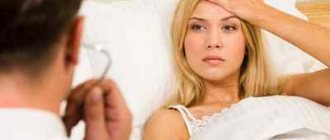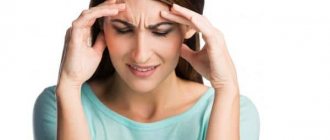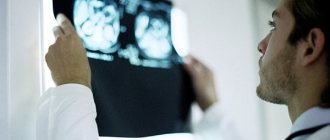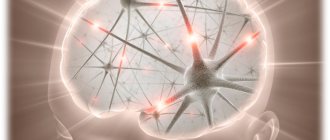Main causes of pathology
As a rule, the main causes of cervical migraine are certain diseases. They are the ones that can provoke severe headaches that arise due to insufficient nutrition of the brain. Let's take a closer look at these diseases:
- Atherosclerosis of the vertebral artery almost always leads to the development of cervical migraine. This disease most often appears in elderly or young people against the background of other chronic diseases. With atherosclerosis of this type, migraines torment a person almost every day.
- The most common cause is considered to be osteochondrosis of the cervical spine. Often this disease is not treated immediately because it is confused with other diseases. So, over time it leads to severe pain in the head.
- If a spinal injury occurs and the cervical spine is affected, then in some cases this also leads to migraine (when an artery is affected). But even without injury, migraine can begin to develop in a person at a young age if there are congenital defects of the cervical spine.
- The most harmless cause of headaches is muscle spasms. This phenomenon is short-term, so it can lead to a severe headache that lasts no more than 2 days. In this case, apart from taking a pain reliever, nothing else is required.
Symptoms of the disease
Before starting treatment, the disease itself should be diagnosed. It is very important to know what exactly needs to be treated so as not to cause more harm to your health. Cervical migraine has several symptoms that are unique to this disease.
Cervical migraine in the initial stages of its development makes itself felt very rarely. But over time, the symptoms become more pronounced and appear more often. If the disease is neglected, headaches will constantly torment the person, and medications will have no effect.
A characteristic feature of cervical migraine is pain that is concentrated in the occipital region. When moving, it will smoothly move to the forehead area, and also radiate into the eye sockets. If a person is in a lying position, the pain may be localized in the back of the head.
If the disease is not at the initial stage, then with sharp turns of the head, darkening of the eyes and even fainting may occur. This is especially pronounced in people with weakened immune systems and older people whose bodies no longer function well enough.
Against the background of severe pain, vision deteriorates sharply. Most often this manifests itself in the fact that “fog” and “floaters” appear before the eyes while reading or looking at something. Sometimes patients' hearing also becomes worse.
At the same time, a severe headache causes nausea, reluctance to eat, and sometimes the pain even provokes vomiting. Very often the body is exhausted during constant migraine attacks, because of this the immune system weakens and weakness is felt.
Prevention
To prevent the syndrome from occurring, it is necessary to monitor the condition of the neck and back muscles and constantly strengthen them. Correct posture is very important. It is always necessary to observe a rest and work schedule. And, naturally, injuries to the spinal column should not be allowed.
Nutrition should be rational, the menu should contain proteins and fiber. It is better to avoid drinking coffee, foods high in carbohydrates and fats. You should not eat food that contributes to the accumulation of salts in the body. In particular, these are table salt, potatoes, sorrel, grapes and milk.
Treatment of cervical migraine
As for the treatment of cervical migraine, everything should depend on the root cause of the disease.
Therapy is divided into standard (taking pharmaceutical drugs) and non-traditional, which includes procedures and adherence to a certain lifestyle. It is best to give preference to complex treatment. But first you need to undergo an examination. The symptoms and treatment for cervical migraines are almost the same as for regular migraines.
Medications
As for medications, the emphasis should be on painkillers and drugs that will improve blood circulation. Among painkillers, No-shpa, Ketanov, Trigan, Nurofen give a good effect. But other tablets may be prescribed (depending on the individual characteristics of the body).
It is also important to understand that taking pills can only relieve the symptoms of cervical migraine. But it is much more important to eradicate the true cause of the disease. Instenon, Cinnarizine are those drugs that partially eliminate the cause of migraine, as they normalize blood circulation.
Along with such drugs, it is very useful to take vitamins. Particular attention should be paid to vitamin B. It is this component that improves brain nutrition. It is also useful to take vitamin C in smaller quantities, especially if a migraine occurs during the cold season.
Rarely, there are still cases when surgery is required. Then doctors perform surgery to remove bone spurs or to stabilize individual cervical vertebrae. But most often this need arises after complex injuries.
Some procedures and useful tips
Therapeutic gymnastics and physical exercise have a very good effect on cervical migraine. Exercises for osteochondrosis will be especially useful, since in this case you can simultaneously work on eliminating pain in the head and normalizing the cervical spine. But it should be clearly understood that the exercises must be prescribed by a doctor. And it is advisable to perform them under the strict guidance of a doctor. Otherwise, you can further damage the cervical spine, which can result in negative consequences.
Massage provides an excellent effect in the treatment of cervical migraine. But this is not an ordinary massage that you can do yourself, but a special one. Its action is aimed at relieving headaches. Massage can be performed either with hands or with special devices. The attending physician decides what type of treatment it will be.
In addition to massage, acupuncture sessions have become widespread recently. The action of the thinnest needles, which are painlessly inserted into certain areas of the body, is aimed at restoring the functioning of certain organs. This is very important, since all organs are connected to each other, and nerves stretch throughout the body. It is through the nerve fibers that impulses are transmitted through needles.
If a person periodically suffers from attacks of cervical migraine, then he needs to spend as much time as possible in the fresh air. It is best to walk more often near the sea or other clean body of water, in the forest. The cleanliness of the air largely determines a person’s well-being. Healing air can sometimes work wonders.
An active lifestyle is the path to recovery. Between migraine attacks, you should try to move a lot. It is especially useful to swim and exercise, do all kinds of stretches. But if there are serious problems with the spine, then any sport should be treated with caution.
Proper, balanced nutrition is of great importance. The patient's diet should be high in fresh fruits and vegetables. You also need to eat fish and meat. But it is best to consume these products boiled or baked. Ideally, you should try to steam dishes, since in this case they retain most of the vitamins of the ingredients. It is absolutely necessary to give up alcohol, since alcohol only slows down the functioning of the brain, which will certainly provoke an exacerbation in the future.
It is necessary to clearly understand that even treatment of cervical migraine at home must first be accompanied by a consultation with the treating doctor. Even a harmless lifestyle change and switching to healthy foods can sometimes have a negative impact on a person’s condition if done very abruptly. Therefore, you need to try to approach everything gradually. Taking pills and vitamins is strictly prohibited without the approval of a doctor. The correct balance of substances in the body is very important.
A disease that occurs as a result of pinched nerves that surround the vertebral artery and is accompanied by migraine-like pain is called cervical migraine. A circulatory disorder in the brain occurs due to impaired blood flow to the vertebral arteries, which causes dizziness, impaired hearing, vision, and reduces performance.
Preventive measures
When working sedentarily, gymnastics must be performed every hour
Treatment of Barre-Lieu syndrome takes a long time and diligently. To prevent its development, you must adhere to the rules of prevention:
- strengthen back muscles;
- when working sedentarily, stretch your neck, perform simple gymnastics, for example, turning your head left and right, bending back and forth;
- avoid hypothermia, do not be in a draft;
- sleep on an orthopedic pillow, the bedding should be comfortable so that the body can rest;
- stop smoking, drinking alcohol and coffee;
- avoid stress.
To prevent migraines, it is important to monitor the health of the musculoskeletal system and blood vessels. It is necessary to eat properly, minimize the consumption of animal fats and trans fats (margarine). If cholesterol levels are elevated, they need to be reduced, otherwise the risk of atherosclerosis increases.
With timely treatment of cervical migraine, the prognosis is favorable. It is important to avoid serious structural changes in the spinal column, otherwise it will be very difficult to relieve pain.
Cervical migraine: symptoms and treatment
Causes of cervical migraine
As a result of age-related disorders and increased loads on the cervical spine, changes in bone and cartilage tissue occur. Such changes provoke chronic diseases and curvature of the spine. Inflammation and spasm of muscle fibers occurs, bone formations compress the soft tissues around the spine. These may be spinal nerve roots, sympathetic nerve fibers, and vertebral arteries that supply the posterior part of the brain.
Cervical migraine can be caused by such common diseases as:
- atherosclerosis,
- cervical osteochondrosis,
- injuries,
- arthrosis,
- cervical lymphadenitis,
- congenital anomalies of the cervical vertebrae and vertebral arteries.
That is, we can say that all causes of cervical migraine are divided into two groups - those associated with damage to the vertebrae (vertebrogenic) and those not associated with problems of the vertebrae (non-vertebrogenic). Diagnosing cervical migraine is quite simple, using X-rays, head tilts, Dopplerography (using a sensor to determine blood pressure and its speed in the vertebral artery). It is better to start treating this disease at an early stage, as it is quite serious.
Symptoms of cervical migraine
Headache is the most important symptom of cervical migraine. This pain can be paroxysmal or constant, which is localized in the back of the head.
1. On one side of the occipital region, severe pain occurs that spreads from the back of the head to the eye socket. Changing the position of the head and neck only increases the pain and is accompanied by itching. Painful sensations occur even when touched. 2. Dizziness, nausea with vomiting, ringing or noise in the ears occurs. There may be a veil or spots before the eyes. 3. In rare cases, it leads to loss of consciousness. Throwing back the head is accompanied by severe dizziness and darkening of the eyes. 4. There is a feeling of heat or chills. There is a feeling of a lump in the throat, which makes swallowing difficult. 5. The sensitivity of the skin in the neck area increases sharply when pressure is applied to the cervical region. When blood flow disturbances are already severe, the patient experiences this condition constantly. This provokes depression, anger, aggression and irritability; you cannot fully rest or work.
Treatment of cervical migraine
Most patients prefer to be treated at home, using painkillers. This gives a short-term effect, and the disease continues to develop. Therefore, it is better to consult a special doctor (neurologist) and be treated under his supervision or in a hospital. The following treatment methods for cervical migraine can be distinguished:
1. Medicines and vitamins
Mandatory use of medications in combination with vitamins. Painkillers and anti-inflammatory drugs, medications for dizziness, and anti-migraine drugs are prescribed. Drugs that improve the nutrition of bone and cartilage tissue.
2. Massage, exercise therapy
Neck massage and physical therapy are a method of preventing and treating the disease in the early stages. Prevents salt deposition and strengthens muscles, improves blood circulation in the cervical region.
3. Physiotherapy
Physiotherapy, acupuncture, physical therapy in the form of a long course.
4. Gymnastics
A weakened cervical ligament can also cause migraines. Prevention in this case will be to strengthen the muscles using special gymnastics for the neck.
5. Orthopedic pillow
You should choose an orthopedic pillow to prevent the disease or treat it in the early stages, since problems may arise due to the uncomfortable position of the neck during sleep.
6. Surgery
If there is a displacement of the vertebrae or it is necessary to remove bone or cartilaginous growths, surgical intervention cannot be avoided. This procedure is quite complicated and risky.
Traditional medicine for the treatment of cervical migraine does not have special methods, but there are many methods for treating ordinary migraine, treating osteochondrosis, atherosclerosis, insomnia and depression, which can also be used for cervical migraine, but they will be less effective.
Diagnostic methods
CT scan of neck vessels with contrast
Determining the cause of pain is quite simple. To begin with, the doctor conducts a visual examination of the cervical spine, palpating the neck and lower part of the head, determining sensitivity and abnormalities in this area. If there is a suspicion of migraine, the patient is prescribed the following diagnostic procedures:
- X-ray of the neck. The pictures show the condition of the spinal column; injuries and degenerative changes can be identified.
- Duplex scanning of blood vessels. Allows you to evaluate blood circulation in the vertebral arteries and identify where areas of narrowing may be located.
- Rheoencephalography. The method helps to identify vessels in which blood circulation is impaired.
- CT, MRI. Tomography is prescribed in complex cases when other visual techniques are not very informative. The most accurate method is MRI, since it allows you to assess the condition of blood vessels, soft tissues, and nerve endings.
The patient is also prescribed a laboratory examination - a blood test for cholesterol.
Folk remedies against cervical migraine
1. Hot tea with sugar and lemon
You can make hot tea with sugar and lemon, but not from a bag, but from leaf tea. Or add lavender, infusion of willow root, raspberry, lemon balm, chamomile, depending on your preference.
2. Massage of the head, neck and ears
Massage the head, neck and, of course, the ears. Movements should be light, leisurely, and round.
3. Bath with essential oils
You can take a soothing and relaxing bath by adding essential oils to the water, mixing them with salt and bubble bath. It is enough to take such a bath for 15 minutes.
4. Lemon peel
You can apply a piece of lemon peel to your temples, and after a few minutes, when it starts to burn, remove it.
5. Aloe juice
You can dissolve 30 drops of fresh aloe juice in half a glass of water.
6. Cold compresses
Cold compresses help relax the nervous system. You can wet your hair with cool water and wrap your head in a towel for an hour to an hour and a half.
7. Grated potato compress
Grate 1 kg on a coarse grater. potatoes, add a little milk until a paste forms. Leave for 30 minutes, then apply it to your forehead and temples, and put on a warming hat. This compress should be applied for an hour, preferably before bedtime. In 8-10 sessions you can recover from the disease.
8. Freshly squeezed cranberry juice
You can use freshly squeezed cranberry juice or alcohol tincture, consuming 50 ml. three times a day.
9. Chicken eggs
Chicken eggs can help. Take 3 eggs, separate the whites from them, add a handful of saffron, mix, apply the mixture on a towel and apply to your forehead. Next, scramble a raw egg in a glass, pour boiling milk over it, stir and drink.
10. Honey and vinegar
Every day, during meals, you need to eat one teaspoon of honey and drink 1 teaspoon of apple cider vinegar in half a glass or a glass of water.
Treatment must be carried out in full and in a timely manner, then the prognosis will be favorable and pain can be relieved. If the disease develops, the prognosis is less favorable and the attacks can only be alleviated.
Cervical migraine - causes, symptoms indicating the disease, diagnosis and treatment with traditional and non-traditional methods.
Cervical migraine - treatment
● Cervical migraine is a disease associated with degenerative changes in the cervical spine. As you know, important “communications” connecting the human body with the brain are compactly packed in the neck.
Due to the fact that there is very little free space in this part of the spine, and it is very vulnerable, pinching of the nerve trunks and blood vessels supplying the brain easily occurs.
● With minimal load and displacement of vertebrae located close to each other, pressure begins on the blood arteries. A pinched artery reduces the amount of blood supplied to the brain, as a result of which the patient, due to insufficient nutrition, exhibits the following symptoms: blurred vision, unsteady gait, decreased hearing, tinnitus, discomfort when tilting the head, and even fainting.
If you have problems with the spine, you are tormented by a hernia and you are afraid to go on the operating table, go to the “ Grandfather’s Secret ” page, where you will find what you have been looking for for a long time, perhaps your healing is waiting for you.
● It should be immediately noted that cervical migraine has nothing in common with classic migraine, but received this name because of pain in the neck and adjacent part of the head.
Cervical migraine - conservative treatment
● Treatment should be aimed at eliminating pain and restoring the biomechanics of the spine, subject to the main condition - ensuring the rest of tense neck muscles.
Inflammation and pain are relieved by taking such nonspecific drugs as: dexalgin , ketonal , ibuprofen and movalis . To improve cerebral circulation, the doctor prescribes drugs that improve cerebral circulation: nicotinic acid, Cavinton , Mexidol , aminophylline , Actovegin , Trental and Cavinton .
● Pathological muscle tension during cervical migraine is relieved by baklosan , sirdalud and mydocalm . In the period between attacks of pain, medications are prescribed that normalize blood supply to cartilage and bone tissue, metabolism: mistletoe extract, B vitamins, arthra, aflutop, aloe extract.
● In the acute period of cervical migraine, warming procedures and ointments are not suitable: they cause increased blood flow to the painful area, contributing to an increase in pain and swelling.
Cold that slows blood circulation is required in the form of an “ice” massage or ointments with menthol. I suggest a simple method: find the pain points on your neck and massage this area with a piece of ice until the skin turns white.
● When the acute period comes to an end, use reflexology and physiotherapy: laser, magnet, UHF, electrophoresis, ultrasound; water procedures: showers and therapeutic baths; paraffin applications that facilitate the massage technique. If you have cervical migraine, remember that the main thing in the treatment and prevention of recurrent headaches is active movement, which will be discussed below.
Cervical migraine – therapeutic exercises
● Cervical migraine does not require bed rest, although it does require limited physical activity. During treatment, it is recommended to fix the neck in the correct position with a Shants orthopedic collar to provide rest to the head and protect it from movements that cause pain. Depending on the patient’s condition, it is worn per day from 10-15 minutes to three hours.
● Please note that a corset is a temporary measure: you must definitely strengthen your neck muscles. Below is a fifteen-minute set of exercises that can be repeated 3-4 times every day.
● Sitting facing the back of a chair with your elbows bent and your fingers pointing towards your shoulders, slowly rotate your arms back 5 to 10 times.
● Sit on a chair, clasp your hands behind your head and slowly move your elbows back as you inhale, and exhale as you move your elbows forward. Repeat 3-10 times.
● Stand straight, feet shoulder-width apart, hands on your waist. Make slow turns with your whole body left and right, in each direction 4-5 times. Breathing is voluntary.
● Sitting on a chair, as you inhale, raise your relaxed arms up, lower them down as you exhale, taking them back and leaning slightly forward (do not lower your head and look straight ahead). Repeat 5-10 times.
● Place your feet shoulder-width apart, hands on your waist, turn your head slowly left and right, tilting it towards your shoulder - in each direction 4-5 times. Breathe freely.
● Sit on a chair and, without holding your breath, placing your hands on your waist, rotate your head 2-3 times in each direction. This achieves stretching of the neck muscles. Freeze for 5-10 seconds when changing direction. Gradually increase the number of rotations. Stop this exercise if your heart rate increases and you feel dizzy.
● Walk in place, raising your knees high each time. Breathe freely.
● Feet shoulder-width apart, raise your arms up - inhale, lower them down - exhale; half squat, relax. Repeat 5-10 times.
● After finishing the set of exercises, perform self-massage: stroking the neck and back of the head from top to bottom, rubbing and kneading, while making circular movements of the shoulder girdle and neck.
● When watching TV, tap yourself with a rolling pin, gradually increasing the blows, on your left shoulder, shoulder blade, spine; then repeat the same on the right side.
● Lie on the floor and roll your back on the rolling pin up and down 50 times.
Cervical migraine - treatment with folk remedies
● Keep in mind that headache problems associated with cervical migraine (osteochondrosis of the cervical spine) did not arise yesterday. A lot of time is spent on the accumulation of salts and pathological changes in the spinal column.
Therefore, the problem cannot be solved in one day: it may take as much time as it took for the disease to develop. But don’t be sad - traditional medicine and herbal medicine will certainly help you.
● During the recovery period, when there is prolonged muscle spasm, traditional medicine recommends using warm compresses and ointments after massaging the sore spot.
The anesthetic ointment consists of bumblebee cones and lard, taken in equal proportions (1:1). After rubbing the back of your head and neck with this mixture before going to bed, wrap them in a woolen scarf (scarf), and in the morning wash with warm water and rub with a towel.
● Pour three tablespoons of a mixture consisting of crushed birch and poplar buds, peppermint herb and dandelion roots, taken equally, with half a glass of boiling water and cook, stirring, over low heat for five minutes.
Mix the finished broth with butter (or lard) and vegetable oil (three tablespoons each). Let cool and store the ointment in the refrigerator. Rub it in and warm the sore spot. Repeat the procedure 3-4 times a day for 5 days.
● Another method of treatment is to rub St. John's wort oil daily, which promotes the regeneration (restoration) of vertebral cartilage. To prepare it, take half a liter of vegetable oil (preferably sea buckthorn) and 150 g of St. John's wort herb.
Place the mixture in a water bath and simmer for half an hour. Leave in the same container for three days. Store the product in the refrigerator, warming it before use.
● People know it as a good distraction remedy for many diseases, including the treatment of cervical migraine. To do this, you need to give yourself a good whipping with a broom made from young stinging nettle.
Other remedies: pepper patch, “pepper acupuncture” with pieces of patch applied to painful points of the shoulders and neck. Keep these “squares” for 3-7 days, but it is better to remove them if there is a strong burning sensation, lubricating the irritated skin with Vaseline.
Cervical migraine – compresses
● Traditional healers and herbalists use compresses in such cases. It is very important not to burn the skin by overexposing them. An excellent decongestant and pain reliever is to apply a cabbage leaf with honey to your neck.
● A mixture of aloe juice with dry mustard in a 1:1 ratio, vodka (1-2 tablespoons), alcohol tincture of propolis (5-10 drops) gives a good effect. Before going to bed, apply the medicine to your neck, covering it with foil and a warm scarf.
● Keep a compress of warm horseradish leaves, scalded with boiling water, until a burning sensation appears.
● Place a compress for half an hour, consisting of a soft cloth soaked in a decoction of dandelion roots, St. John's wort and burdock roots (boil 3 tablespoons of the mixture for 5 minutes in half a glass of water).
● Infusion to activate cerebral circulation. Pour a glass of boiling water over a teaspoon of meadowsweet flowers for two hours and drink for three weeks every two hours before meals. Another infusion of lemon balm or peppermint will help you with headaches and tinnitus.
Clinical picture
The pathology is characterized by frequent pain in the neck and back of the head, which can radiate to the temporal and parietal parts of the head. The pain can be described as throbbing, burning, which increases with head movement.
The patient may have problems with balance, and there may be darkening and blurred vision in the eyes. The syndrome significantly affects mental and physical performance.










